Video: Japanese secret of producing 0.0001mm thin gold leaf
Kanazawa is a famous ancient city in Japan, with many traditional handicraft products, the most famous being gold leaf.
Most of the gold leaf consumption in Japan was produced in Kanazawa. The gold leaf craft in Kanazawa has a history of more than 400 years ago.

Leaf gold is often used for plating statues of souvenirs, decorations .
The process of making gold leaves manually undergoes many meticulous steps. The gold is thinly dispersed with a hammer, until it reaches a thickness of only 0.0001mm. Leaf gold produced in Kanazawa is so thin that it can be seen through.
Secrets of making these ultra-thin gold leaf plates are the traditional ganpishi sheets.
Paper soaked in a mixture of: straw, eggs and pink juice. They are used to grip gold during thin canopy. This helps the gold leaf to be thinly spread, shiny and uneven.
Currently only about 40 artisans make handmade gold leaves in Kanazawa. Leaf gold is often used for plating statues of souvenirs, decorations .
- Successfully manufactured the world's thinnest gold leaf
- Producing 24-karat gold with bacteria
- The past is to display the process of producing rare and precious gold pearls
- The truth behind the gold-plated dishes of the super rich world
- Treasure legend: Yamashita Gold Warehouse (Part 4)
- Revealing the secret of life expectancy like Japanese people
- Gold leaf helps to charge the phone by folding the finger
- Gold skin care technology
- Visit the most secret places on the planet
- This secret has helped the Japanese become a nation
- Gold is formed like?
- The interesting thing about gold may be unknown to you
 Why does steam cause burns worse than boiling water?
Why does steam cause burns worse than boiling water? Lightning-fast octopus is amazing
Lightning-fast octopus is amazing Video: The secret to quickly fold clothes in just 2 seconds for busy people
Video: The secret to quickly fold clothes in just 2 seconds for busy people The eel waving off his head still bites the can of water
The eel waving off his head still bites the can of water